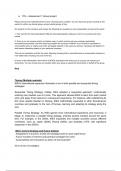● 15% - Assessment 1 Group project
Please choose one multinational firm of your choosing (only condition: we can’t have two groups working on the
same firm within one tutorial group; across tutorial groups is fine).
Do research on this company and answer the following two questions in your presentation as well as the report:
1. How has this firm internationalized? Map the internationalization pathway in terms of countries and entry
modes.
2. Zoom in on one success and/or one failure case. In which country was your company particularly
successful/unsuccessful, and how would you explain this success or failure? If you choose a successful or
unsuccessful entry, or maybe even both, will largely depend on the case you choose, meaning it will depend on
what seems interesting based on your particular company.
This has no implication at all for the mark. Meaning choosing both a successful and an unsuccessful instance is
*not* better than choosing only one of the two.
In terms of the deliverables, there will be a KEATS submission link where you as a group can upload your
documents. You can choose any one student within your group to upload the documents on behalf of the group.
Ikea
Timing (Multiple markets)
IKEA's international expansion illustrates a mix of both parallel and sequential timing
strategies:
Sequential Timing Strategy: Initially, IKEA adopted a sequential approach, methodically
entering new markets one at a time. This approach allowed IKEA to learn from each market
entry and apply those lessons to subsequent expansions. For instance, after establishing its
first store outside Sweden in Norway, IKEA methodically expanded to other Scandinavian
countries and gradually to the rest of Europe, learning and adapting its strategy along the
way.
Parallel Timing Strategy: As IKEA gained more international experience and resources, it
began to implement a parallel timing strategy, entering several markets around the same
time. For example, in the 2000s, IKEA expanded into multiple countries across different
continents, such as Japan (2006), Russia (2000), and Australia (1975, with significant
expansion in the 2000s).
IKEA's Current Strategy and Future Outlook
- Adaptations in business model and strategy based on past experiences
- Future markets of interest and potential strategies for entry
- Sustainability and innovation as pillars of future growth
SO in terms of strategies,
, IKEA’s current strategy
1. Local Adaptation
- IKEA places importance on adapting its product offerings and store layouts to local
tastes and cultural preferences
- (other wording: IKEA continues to localize its product assortment to meet regional
tastes and preferences, reflecting cultural nuances and living conditions in different
markets.
- The company is diversifying its product range to include not just furniture but also
affordable home solutions and smart home products.
- E.g. in Asia, IKEA offers more compact furniture and home solutions to align with
smaller living spaces
- “In 2006, IKEA made a strategic comeback to Japan, this time with a localized
approach that emphasized adaptation to local preferences. The company introduced
smaller-sized furniture designs, tailored to the limited spaces of Japanese
households. IKEA partnered with local assembly services to offer convenient and
profound furniture assembly services, aligning with Japanese preferences.
- “IKEA’s marketing campaigns in Japan also underwent a transformation,
incorporating local cultural references and values. The company used traditional
Japanese art and design elements in its store décor and marketing materials, creating
a more immersive and culturally appropriate experience for Japanese consumers.”
- https://www.accelingo.com/ikeas-localization-strategy/#:~:text=The%20company%2
0introduced%20smaller%2Dsized%20furniture%20designs%2C%20tailored%20to%20
the,services%2C%20aligning%20with%20Japanese%20preferences.
- China - One of the primary challenges IKEA faced in China was the cultural norm of
having furniture professionally assembled. In Swedish culture, self-assembly is seen
as a badge of honour, symbolizing resourcefulness and DIY capabilities. However, in
China, furniture assembly is considered a time-consuming and undesirable task,
often assigned to hired professionals.
- To address this cultural barrier and enhance customer convenience, IKEA made a
strategic decision to partner with local furniture assembly services in China. This
move proved to be a game-changer, allowing IKEA to tap into the existing expertise
of local professionals while still maintaining its commitment to affordable furniture.
- The partnership with local assembly services not only addressed customer
preferences but also created new employment opportunities and strengthened
IKEA’s ties with the Chinese community. As a result of this adaptation, IKEA’s sales in
China skyrocketed, reaching $1.6 billion in 2019
2. Enhanced Digital Integration
- IKEA recognises the shift towards online shopping and has since significantly
improved their digital platforms and e-commerce solutions.




